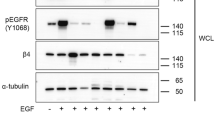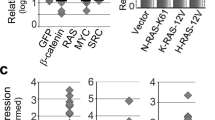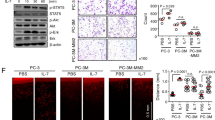Abstract
Integrin-linked kinase (ILK) is a mediator of aggressive phenotype in pancreatic cancer. On the basis of our finding that knockdown of either KRAS or ILK has a reciprocal effect on the other’s expression, we hypothesized the presence of an ILK-KRAS regulatory loop that enables pancreatic cancer cells to regulate KRAS expression. This study aimed to elucidate the mechanism by which this regulatory circuitry is regulated and to investigate the translational potential of targeting ILK to suppress oncogenic KRAS signaling in pancreatic cancer. Interplay between KRAS and ILK and the roles of E2F1, c-Myc and heterogeneous nuclear ribonucleoprotein as intermediary effectors in this feedback loop was interrogated by genetic manipulations through small interfering RNA/short hairpin RNA knockdown and ectopic expression, western blotting, PCR, promoter-luciferase reporter assays, chromatin immunoprecipitation and pull-down analyses. In vivo efficacy of ILK inhibition was evaluated in two murine xenograft models. Our data show that KRAS regulated the expression of ILK through E2F1-mediated transcriptional activation, which, in turn, controlled KRAS gene expression via hnRNPA1-mediated destabilization of the G-quadruplex on the KRAS promoter. Moreover, ILK inhibition blocked KRAS-driven epithelial–mesenchymal transition and growth factor-stimulated KRAS expression. The knockdown or pharmacological inhibition of ILK suppressed pancreatic tumor growth, in part, by suppressing KRAS signaling. These studies suggest that this KRAS-E2F1-ILK-hnRNPA1 regulatory loop enables pancreatic cancer cells to promote oncogenic KRAS signaling and to interact with the tumor microenvironment to promote aggressive phenotypes. This regulatory loop provides a mechanistic rationale for targeting ILK to suppress oncogenic KRAS signaling, which might foster new therapeutic strategies for pancreatic cancer.
This is a preview of subscription content, access via your institution
Access options
Subscribe to this journal
Receive 50 print issues and online access
$259.00 per year
only $5.18 per issue
Buy this article
- Purchase on Springer Link
- Instant access to full article PDF
Prices may be subject to local taxes which are calculated during checkout









Similar content being viewed by others
References
Almoguera C, Shibata D, Forrester K, Martin J, Arnheim N, Perucho M . Most human carcinomas of the exocrine pancreas contain mutant c-K-ras genes. Cell 1988; 53: 549–554.
Morris JPt, Wang SC, Hebrok M . KRAS, Hedgehog, Wnt and the twisted developmental biology of pancreatic ductal adenocarcinoma. Nat Rev Cancer 2010; 10: 683–695.
Pylayeva-Gupta Y, Grabocka E, Bar-Sagi D . RAS oncogenes: weaving a tumorigenic web. Nat Rev Cancer 2011; 11: 761–774.
di Magliano MP, Logsdon CD . Roles for KRAS in pancreatic tumor development and progression. Gastroenterology 2013; 144: 1220–1229.
Eser S, Schnieke A, Schneider G, Saur D . Oncogenic KRAS signalling in pancreatic cancer. Br J Cancer 2014; 111: 817–822.
Hingorani SR, Petricoin EF, Maitra A, Rajapakse V, King C, Jacobetz MA et al. Preinvasive and invasive ductal pancreatic cancer and its early detection in the mouse. Cancer Cell 2003; 4: 437–450.
Guerra C, Schuhmacher AJ, Canamero M, Grippo PJ, Verdaguer L, Perez-Gallego L et al. Chronic pancreatitis is essential for induction of pancreatic ductal adenocarcinoma by K-Ras oncogenes in adult mice. Cancer Cell 2007; 11: 291–302.
Seidler B, Schmidt A, Mayr U, Nakhai H, Schmid RM, Schneider G et al. A Cre-loxP-based mouse model for conditional somatic gene expression and knockdown in vivo by using avian retroviral vectors. Proc Natl Acad Sci USA 2008; 105: 10137–10142.
Aguirre AJ, Bardeesy N, Sinha M, Lopez L, Tuveson DA, Horner J et al. Activated Kras and Ink4a/Arf deficiency cooperate to produce metastatic pancreatic ductal adenocarcinoma. Genes Dev 2003; 17: 3112–3126.
Hingorani SR, Wang L, Multani AS, Combs C, Deramaudt TB, Hruban RH et al. Trp53R172H and KrasG12D cooperate to promote chromosomal instability and widely metastatic pancreatic ductal adenocarcinoma in mice. Cancer Cell 2005; 7: 469–483.
Collins MA, Bednar F, Zhang Y, Brisset JC, Galban S, Galban CJ et al. Oncogenic Kras is required for both the initiation and maintenance of pancreatic cancer in mice. J Clin Invest 2012; 122: 639–653.
Young A, Lyons J, Miller AL, Phan VT, Alarcon IR, McCormick F . Ras signaling and therapies. Adv Cancer Res 2009; 102: 1–17.
Gysin S, Salt M, Young A, McCormick F . Therapeutic strategies for targeting ras proteins. Genes Cancer 2011; 2: 359–372.
Hannigan G, Troussard AA, Dedhar S . Integrin-linked kinase: a cancer therapeutic target unique among its ILK. Nat Rev Cancer 2005; 5: 51–63.
McDonald PC, Fielding AB, Dedhar S . Integrin-linked kinase—essential roles in physiology and cancer biology. J Cell Sci 2008; 121: 3121–3132.
Hannigan GE, McDonald PC, Walsh MP, Dedhar S . Integrin-linked kinase: not so 'pseudo' after all. Oncogene 2011; 30: 4375–4385.
Hannigan GE, Leung-Hagesteijn C, Fitz-Gibbon L, Coppolino MG, Radeva G, Filmus J et al. Regulation of cell adhesion and anchorage-dependent growth by a new beta 1-integrin-linked protein kinase. Nature 1996; 379: 91–96.
Tu Y, Li F, Goicoechea S, Wu C . The LIM-only protein PINCH directly interacts with integrin-linked kinase and is recruited to integrin-rich sites in spreading cells. Mol Cell Biol 1999; 19: 2425–2434.
Tu Y, Huang Y, Zhang Y, Hua Y, Wu C . A new focal adhesion protein that interacts with integrin-linked kinase and regulates cell adhesion and spreading. J Cell Biol 2001; 153: 585–598.
Lee SL, Chou CC, Chuang HC, Hsu EC, Chiu PC, Kulp SK et al. Functional Role of mTORC2 versus Integrin-linked Kinase in mediating Ser473-Akt phosphorylation in PTEN-negative prostate and breast cancer cell lines. PLoS One 2013; 8: e67149.
Yau CY, Wheeler JJ, Sutton KL, Hedley DW . Inhibition of integrin-linked kinase by a selective small molecule inhibitor, QLT0254, inhibits the PI3K/PKB/mTOR, Stat3, and FKHR pathways and tumor growth, and enhances gemcitabine-induced apoptosis in human orthotopic primary pancreatic cancer xenografts. Cancer Res 2005; 65: 1497–1504.
Sawai H, Okada Y, Funahashi H, Matsuo Y, Takahashi H, Takeyama H et al. Integrin-linked kinase activity is associated with interleukin-1 alpha-induced progressive behavior of pancreatic cancer and poor patient survival. Oncogene 2006; 25: 3237–3246.
Schaeffer DF, Assi K, Chan K, Buczkowski AK, Chung SW, Scudamore CH et al. Tumor expression of integrin-linked kinase (ILK) correlates with the expression of the E-cadherin repressor snail: an immunohistochemical study in ductal pancreatic adenocarcinoma. Virchows Archiv 2010; 456: 261–268.
Paramasivam M, Membrino A, Cogoi S, Fukuda H, Nakagama H, Xodo LE . Protein hnRNP A1 and its derivative Up1 unfold quadruplex DNA in the human KRAS promoter: implications for transcription. Nucleic Acids Res 2009; 37: 2841–2853.
Farre D, Roset R, Huerta M, Adsuara JE, Rosello L, Alba MM et al. Identification of patterns in biological sequences at the ALGGEN server: PROMO and MALGEN. Nucleic Acids Res 2003; 31: 3651–3653.
Meng P, Ghosh R . Transcription addiction: can we garner the Yin and Yang functions of E2F1 for cancer therapy? Cell Death Dis 2014; 5: e1360.
Cogoi S, Xodo LE . G-quadruplex formation within the promoter of the KRAS proto-oncogene and its effect on transcription. Nucleic Acids Res 2006; 34: 2536–2549.
Cogoi S, Paramasivam M, Membrino A, Yokoyama KK, Xodo LE . The KRAS promoter responds to Myc-associated zinc finger and poly(ADP-ribose) polymerase 1 proteins, which recognize a critical quadruplex-forming GA-element. J Biol Chem 2010; 285: 22003–22016.
Lee SL, Hsu EC, Chou CC, Chuang HC, Bai LY, Kulp SK et al. Identification and characterization of a novel integrin-linked kinase inhibitor. J Med Chem 2011; 54: 6364–6374.
David CJ, Chen M, Assanah M, Canoll P, Manley JL . HnRNP proteins controlled by c-Myc deregulate pyruvate kinase mRNA splicing in cancer. Nature 2010; 463: 364–368.
Ardito CM, Gruner BM, Takeuchi KK, Lubeseder-Martellato C, Teichmann N, Mazur PK et al. EGF receptor is required for KRAS-induced pancreatic tumorigenesis. Cancer Cell 2012; 22: 304–317.
Navas C, Hernandez-Porras I, Schuhmacher AJ, Sibilia M, Guerra C, Barbacid M . EGF receptor signaling is essential for k-ras oncogene-driven pancreatic ductal adenocarcinoma. Cancer Cell 2012; 22: 318–330.
Singh A, Greninger P, Rhodes D, Koopman L, Violette S, Bardeesy N et al. A gene expression signature associated with "K-Ras addiction" reveals regulators of EMT and tumor cell survival. Cancer Cell 2009; 15: 489–500.
Serrano I, McDonald PC, Lock FE, Dedhar S . Role of the integrin-linked kinase (ILK)/Rictor complex in TGFbeta-1-induced epithelial-mesenchymal transition (EMT). Oncogene 2013; 32: 50–60.
Wang Z, Ali S, Banerjee S, Bao B, Li Y, Azmi AS et al. Activated K-Ras and INK4a/Arf deficiency promote aggressiveness of pancreatic cancer by induction of EMT consistent with cancer stem cell phenotype. J Cell Physiol 2013; 228: 556–562.
Liu TM, Ling Y, Woyach JA, Beckwith K, Yeh YY, Hertlein E et al. OSU-T315: a novel targeted therapeutic that antagonizes AKT membrane localization and activation of chronic lymphocytic leukemia cells. Blood 2014; 125: 284–295.
Campbell SL, Khosravi-Far R, Rossman KL, Clark GJ, Der CJ . Increasing complexity of Ras signaling. Oncogene 1998; 17: 1395–1413.
Kalra J, Sutherland BW, Stratford AL, Dragowska W, Gelmon KA, Dedhar S et al. Suppression of Her2/neu expression through ILK inhibition is regulated by a pathway involving TWIST and YB-1. Oncogene 2010; 29: 6343–6356.
Evdokimova V, Tognon C, Ng T, Ruzanov P, Melnyk N, Fink D et al. Translational activation of snail1 and other developmentally regulated transcription factors by YB-1 promotes an epithelial-mesenchymal transition. Cancer Cell 2009; 15: 402–415.
Kang Y, Massague J . Epithelial-mesenchymal transitions: twist in development and metastasis. Cell 2004; 118: 277–279.
Jean-Philippe J, Paz S, Caputi M . hnRNP A1: the Swiss army knife of gene expression. Int J Mol Sci 2013; 14: 18999–19024.
Zhou ZJ, Dai Z, Zhou SL, Fu XT, Zhao YM, Shi YH et al. Overexpression of HnRNP A1 promotes tumor invasion through regulating CD44v6 and indicates poor prognosis for hepatocellular carcinoma. Int J Cancer 2013; 132: 1080–1089.
Hsu EC, Kulp SK, Huang HL, Tu HJ, Salunke SB, Sullivan NJ et al. Function of integrin-linked kinase in modulating the stemness of IL-6-abundant breast cancer cells by regulating gamma-secretase-mediated notch1 activation in caveolae. Neoplasia 2015; 17: 497–508.
Bommert KS, Effenberger M, Leich E, Kuspert M, Murphy D, Langer C et al. The feed-forward loop between YB-1 and MYC is essential for multiple myeloma cell survival. Leukemia 2013; 27: 441–450.
Gregory MA, Qi Y, Hann SR . Phosphorylation by glycogen synthase kinase-3 controls c-myc proteolysis and subnuclear localization. J Biol Chem 2003; 278: 51606–51612.
Yarden Y, Sliwkowski MX . Untangling the ErbB signalling network. Nat Rev Mol Cell Biol 2001; 2: 127–137.
Stolzenberg-Solomon RZ, Graubard BI, Chari S, Limburg P, Taylor PR, Virtamo J et al. Insulin, glucose, insulin resistance, and pancreatic cancer in male smokers. JAMA 2005; 294: 2872–2878.
Acknowledgements
This work was supported by the Lucius A Wing Endowed Chair Fund (CSC), Ministry of Science and Technology grant MOST 103-2320-B-001-017 (PCC), Bi-institutional Collaborative Pancreatic Cancer Research grants from National Cheng Kung University College of Medicine (CSC) and The Ohio State University Wexner Medical Center and Comprehensive Cancer Center (TBS) and National Institutes of Health grant P30 CA016058, which supports, in part, the Comparative Pathology and Mouse Phenotyping Shared Resource at The Ohio State University Comprehensive Cancer Center.
Author information
Authors and Affiliations
Corresponding author
Ethics declarations
Competing interests
The authors declare no conflict of interest.
Additional information
Supplementary Information accompanies this paper on the Oncogene website
Supplementary information
Rights and permissions
About this article
Cite this article
Chu, PC., Yang, MC., Kulp, S. et al. Regulation of oncogenic KRAS signaling via a novel KRAS-integrin-linked kinase-hnRNPA1 regulatory loop in human pancreatic cancer cells. Oncogene 35, 3897–3908 (2016). https://doi.org/10.1038/onc.2015.458
Received:
Revised:
Accepted:
Published:
Issue Date:
DOI: https://doi.org/10.1038/onc.2015.458
This article is cited by
-
Integrin-linked kinase (ILK) regulates KRAS, IPP complex and Ras suppressor-1 (RSU1) promoting lung adenocarcinoma progression and poor survival
Journal of Molecular Histology (2020)
-
Mutant KRAS promotes liver metastasis of colorectal cancer, in part, by upregulating the MEK-Sp1-DNMT1-miR-137-YB-1-IGF-IR signaling pathway
Oncogene (2018)
-
The cellular protein hnRNP A2/B1 enhances HIV-1 transcription by unfolding LTR promoter G-quadruplexes
Scientific Reports (2017)
-
Role of integrin-linked kinase in regulating the protein stability of the MUC1-C oncoprotein in pancreatic cancer cells
Oncogenesis (2017)



